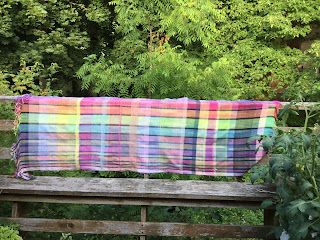Here is the array of painted warps on 2/8 cotton:
Once I really get the hang of what I'm doing when I paint, I'll tell you more about the process. Anyone who knows me, knows I like to measure accurately both so that colours are reproducible and so as not to waste materials like dye stock. I found very little information to help me with that when it came to painting on cellulose with MX dyes so I am developing my own spreadsheets and procedures; when I'm happy with them, I'll find a way to share them.
My friend Ann came over and we had a play day. She has a large box of assorted MX dyes, including an alarming number of greens. I couldn't quite give up the measuring, but these little skeins for weft were mostly thrown together, with the inevitable result that I can't reproduce that lovely warm brown, sigh. I did learn about low water immersion techniques, however. There are a variety of fibres represented: 2/8 and 2/16 cotton, 2/8 bamboo, cottolin and hemp/cotton. The bamboo is the shiny, purple one in the middle.
When Jan came to help me put the warp on the loom she decided we needed something to separate the different painted warps, so I wound narrow stripes of navy and black to divide them. Jan helped me get the warp on and made sure I was getting the hang of threading then left me to work on my own. I thread to a straight draw (4-3-2-1) and then sleyed the reed with a variety of setts from 16epi to 30epi. This took some head scratching and resleying as I realized I hadn't counted width correctly... It also made tension and beating a little different, but the result was worth it. I started playing with a variety of weft colours, first in plain weave and then, as I got bolder, a variety of twills. It took me most of the 3 yard warp to get comfortable throwing the shuttle, mostly because I wasn't putting enough tension on the warp at first. It is one thing that is quite different on the floor loom, compared to the RH loom.
The final cloth is beautiful in a random kind of way. Everyone keeps asking me what it will be and I tell them it already is what it was intended to be: a learning experience and a reference.
I can feel and see the differences in the setts, wefts and weave structures. I can see how the weft colour and size interacts with the different colours and how the stripes show up. It provides a ton of information I can use to plan projects and I learned a ton winding warp, painting warp, dressing the loom and weaving.
And yes, I actually like the floor loom. This one isn't as noisy as many looms are and boy, is it fast! I think the fact that she is an antique adds to her appeal. She is a direct tie up jack loom, a simple workhorse who still works very well despite her age - she is somewhere between 100 and 115 years old. She started her life in a nunnery in Quebec and was used there well into the mid 20th Century, Jan adopted her at the Great Glebe Garage Sale in the late 1980's but she has been in storage a lot since; she deserves to be used. She is missing some original hardware, but my Dad (the machinist) and Jan's husband Glenn (the blacksmith) can make more authentic replacements at some point.




